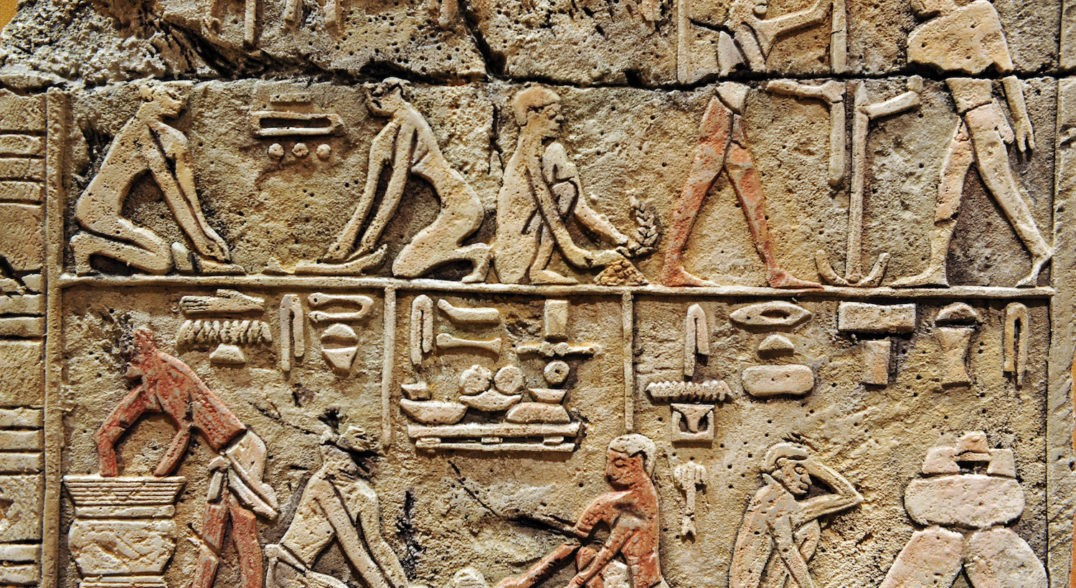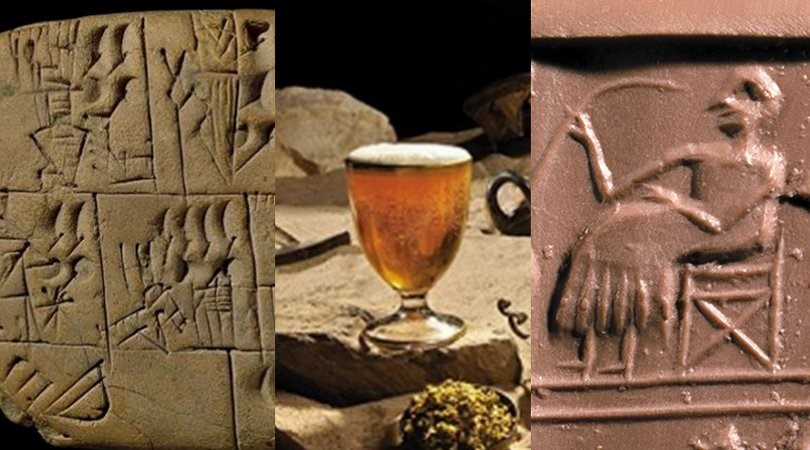"பண்டைய சுமேரியரின் உணவு பழக்கங்கள் தொடர்கிறது"" [ஆங்கிலத்திலும் தமிழிலும் / In English and Tamil]
இன்று சிரியா, ஈராக் மற்றும் துருக்கி ஆகிய பகுதிகளே, இன்று நாம் சமையலில் பயன்படுத்தும் பல பொருட்களுக்கு பூர்வீகம் ஆகும். கடந்த 24 மணிநேரத்தில் நீங்கள் உண்ணும் கலோரிகளில் 50 சதவிகிதம், இந்த பகுதியில் முதலில் வளர்க்கப்பட்ட காய்கறிகள் அல்லது விலங்குகளிலிருந்து வந்திருக்கும் என்று நான் சொல்லுகிறேன். அதை சரி பார்க்க, யேல் சமையல் பலகை ஒன்றில் ஒரு சமையல் குறிப்பை இனிப் பார்ப்போம்.
"தலையையும் பாதத்தையும் அகற்று, உடலை விரித்து பறவையை கழுவு, பின் இரைப்பை, இதயம், கல்லீரல், நுரையீரல் போன்றவற்றை பிடுங்கி ஒதுக்கி வை, பின் இரைப்பையை பிரித்து துப்பரவு செய், அடுத்து, அந்த பறவையின் உடலை அலசி [கழுவி] அதை தட்டையாக கிடத்து, ஒரு சட்டி எடுத்து அதற்குள் பறவையின் உடலையும் இரைப்பையையும் மற்றும் இதயம், கல்லீரல், நுரையீரலையும் போட்டு பின் அடுப்பில் வைக்கவும்" ஆனால் நீர் அல்லது கொழுப்பு சேர்த்து அடுப்பில் வைக்க வேண்டும் என்பது குறிப்பிடப்பட வில்லை. இது ஒரு பொதுவான பழக்கப்பட்ட சமையல் என்பதால், அறிவுறுத்தல் ஒன்றும் தேவையில்லை என அதிகமாக விட்டிருக்கலாம்? சமையல் குறிப்பு மீண்டும் இப்படி தொடர்கிறது:
"முதலாவது கொதித்தலின் அல்லது கொழுப்பில் பழுப்பாய் வறுத்த பின், மீண்டும் சட்டியை நெருப்பில் வை, புதிய தண்ணீரால் சட்டியை கழுவு, பாலை நன்றாய் அடிச்சு சட்டியில் விட்டு பறவையுடன் நெருப்பில் வை, பின் சட்டியை எடுத்து வடி, சாப்பிட முடியாத பறவையின் பகுதிகளை வெட்டி ஏறி, மற்றவைக்கு உப்பு சேர், அவையை சட்டியில் பாலுடனும் கொஞ்ச கொளுப்புடனும் இடு, மேலும் இதனுடன் சில ஏற்கனவே கழுவி உரித்து வைக்கப்பட்ட அரூத அல்லது அருவதா என்ற மூலிகையை சேர். [சதாப்பு இலை / இப்பயிர் மலைப் பிரதேசங்களில்செளிப்பான காடுகளில் இயற்கையாக வளர்கிறது. இது வரட்சியைத்தாங்கக் கூடியது. அருவதா செடிகளை எல்லா வகையான மண்ணிலும் வளர்க்கலாம்], அந்த கலவை கொதிக்கத் தொடங்கியதும், அதனுடன் துண்டு துண்டாக வெட்டப்பட்ட அல்லது நறுக்கிய லீக்ஸ், மற்றும் உள்ளி, சமிடு [ரவை?], போதுமான வெங்காயம் சேர்த்து கொள்,"
இப்படி பறவையை சமைக்கும் அதே தருவாயில், சமைத்த உணவை பரிமாறுதலுக்கான ஆயுத்தமும் செய்யவேண்டும் என்பதால், அதன் அறிவுறுத்தல் மேலும் இப்படி தொடர்கிறது: "நொறுக்கப்பட்ட தானியத்தை கழுவு, பாலில் அதை மென்மையாக்கு, அதை பிசையும் போது, உப்பு, ரவை, லீக்ஸ், உள்ளியும் அத்துடன் தேவையான பாலும் எண்ணெயும் கலந்து மென்மையான கூழாக்கி - மாவு பசையாக்கி-, அதை ஒரு சில நேரம் நெருப்பில் வாட்டு. பின் இரு துண்டுகளாக வெட்டு, பின் பறவையை தாங்கக் கூடிய பெரிய தட்டை எடு, தட்டின் அடியில் முன்னமே மேற்கூறிய வாறு தயாரிக்கப்பட்ட பிசைந்த மாவை வை, விளும்புக்கு வெளியே அது பெரிதாக தொங்க்காத வாறு பார்த்துக்கொள், அடுப்பிற்கு மேல் அதை வேக வை, ஏற்கனவே பக்குவபடுத்தப்பட்ட அந்த வெந்த பிசைந்த மாவிற்கு மேல் பறவையின் உடலையும் மற்றும் பிடுங்கி எடுத்த பகுதிகளையும் வை, அதை ரொட்டி மூடியால் மூடு. பின் அதை பரிமாறலுக்கு அனுப்பு."என்கிறது. மூன்றாவது யேல் சமையல் பலகை, மிகவும் சிறியதாகவும் அதே நேரம் மிகவும் உடைந்த தாகவும் உள்ளது. இது மூன்று சமையல் குறிப்பை கொண்டுள்ளது. இது ஒரு பானையில் பறவை ஒன்றின் சமையல்கள் ஆகும். அடையாளம் காணப்படாத ஒரு வித தானியம் [butumtu?] - அதிகமாக இது பசுங்கொட்டை அல்லது அதன் மாவாக இருக்கலாம் [Pistachio Nuts or Flour]?- இறைச்சி போன்றவையை சேர்த்து சமைக்கும் ஒரு முறையாகும். என்றாலும் நின்காசியை கௌரவிக்கும் கி மு 1900 ஆண்டு துதி பாடல் ஒன்றே [Sumerian Hymn to Ninkasi] உலகின் முதல் முழுமையான, சமையல் புத்தகமாக கருதப்படுகிறது.
சுமேரியர்கள் பியர் மது குடிப்பதில் மிகவும் பிரியமானவர்கள். என்றாலும் உண்மையில், தற்செயலாகத்தான் இந்த சாராயத்தை கண்டு பிடித்தார்கள் என நம்பப்படுகிறது. சுமேரியர்கள் நாடோடி - வேட்டையாடுபவர்களாக முதலில் மெசொப்பொத்தேமியாவில் குடியேறி விவசாயம் செய்ய ஆரம்பித்தார்கள். அவர்கள் செய்த முதல் அறுவடை, ஒரு தானியம் ஆகும். இந்த தானியத்தை பேணி நீண்ட காலத்திற்கு வைத்திருப் பதற்க்காக, கி மு 4000 ஆண்டுகளுக்கு முன், இந்த தானியத்தை வேகவைத்து சேமித்தனர். இப்படி வேகவைத்த இனிமையான தானியங்கள் நாளடைவில், ஈரமாகி, அதன் பின் அது ஒரு மகிழ்ச்சியான, உணர்வு தரத்தக்க, மயக்கம் தர வல்ல, பானம் ஒன்றைத் தந்தது. இதுவே உலகின் முதல் மது ஆகும். இது ஒரு தற்செயலான கண்டு பிடிப்பாகும். அதன் பின், சுமேரியன் வேகவைத்த தானியத்தை நொறுக்கி தண்ணீர் உள்ள பானை ஒன்றிற்குள் தள்ளினான். சிலவேளை, அவன் அதற்கு நறுமண பொருட்கள், பழங்கள் அல்லது தேன் போன்றவற்றை சேர்த்தான். அதன் பின் அதை புளிக்க வைத்து மது தயாரித்தான்.அப்படி தயாரிக்கப்பட்ட அந்த மதுவை பானையில் இருந்து பாபிலோனியன், சில ஆண்டுகள் கழித்து, ஒரு உறிஞ்சி மூலம் குடித்து மகிழப் பழகினான் என அறிஞர்கள் கூறுகிறார்கள்.
சுமேரியர்களால், தமது “வாய் நிரப்பும் பெண்மணி" என போற்றப்படும், "மது பெண் தெய்வ" மான நின்காசியை துதித்து போற்றும் சிறப்பு மிக்க - உலகின் முதல் முழுமையான, சமையல் புத்தகமாக கருதப்படும் - ஒரு துதி பாடல், மது வடித்தலுக்கான சேர்மானங்களையும் செய்முறையையும் [recipe for brewing] வரிசையாக எடுத்துக் கூறி, அந்த பண்டைய பெண் தெய்வத்தை அப்பாடல், பாராட்டுகிறது. இது புளிக்கச் செய்யப்பயன் படும் பொருள் முதல், ஊறவைத்தல், நொதித்தல், வடித்தல் என்பனவற்றின் விபரங்களை ஒவ்வொன்றாகத் வரிசையாகத் தருகிறது. பொதுவாக பண்டைய மெசொப்பொத்தேமியாவில் மது வடிப்போர் / காய்ச்சுவோர் பெண்களாக இருந்தார்கள், அதிகமாக நின்காசியின் பெண் குருவே இவர்கள். மேலும் அங்கு துணை உணவாக மது,வீட்டில் பெண்களால் வடிக்கப்பட்டது அல்லது காய்ச்சப்பட்டது. எனவே வீட்டு பணிகளுடன் மேல் அதிகமாக அவர்கள் தாம் வடித்த அந்த ஒரு வகைச் சாராயத்தை / பியர் மது பானத்தை [beer] விற்கவும் அவர்களால் முடியும். அதாவது சுமேரிய பெண்கள் தவறணை காப்பாளராகவும் அன்று இருக்கக் கூடியதாக இருந்தது.
நன்றி -
[கந்தையா தில்லைவிநாயகலிங்கம்,
அத்தியடி, யாழ்ப்பாணம்]
பகுதி : 14 தொடரும்
Theebam.com: "தமிழரின் உணவு பழக்கங்கள்"பகுதி: 01:
"FOOD HABITS OF TAMILS" PART: 13
"Food Habits Of Ancient Sumer continuing"
Many of the ingredients we use in cooking today are
native to the regions of Syria, Iraq, and Turkey. I'd say 50 percent of the
calories you eat in the last 24 hours should have come from vegetables or
animals that were originally grown in this area. To verify that, let's look at
a recipe from a Yale cookbook.
"Remove the head and feet. Open the body and
clean the birds, reserving the gizzards and the pluck [heart, liver, and
lungs]. Split the gizzards and clean them. Next rinse the birds and flatten
them. Prepare a pot and put birds, gizzards and pluck into it before placing it
on the fire" It does not mention whether fat or water is added - no doubt
the method was so familiar that instructions were considered unnecessary -
After the initial boiling or braising, the recipe continues-
"Put the pot back on the fire. Rinse out a pot
with fresh water. Place beaten milk into it and place it on the fire. Take the
pot (containing the birds) and drain it. Cut off the inedible parts, then salt
the rest, and add them to the vessel with the milk, to which you must add some
fat. Also add some rue [aromatic woody
herbs or shrubs], which has already been stripped and cleaned. When it has come
to a boil, add minced leek, garlic, samidu [Semolina?] and onion (but not too
much onion)" While the birds cook, preparations for serving the dish must
be made -
"Rinse crushed grain, then soften it in milk and
add to it, as you kneed it, salt, samidu, leeks and garlic along with enough
milk and oil so that a soft dough will result which you will expose to the heat
of the fire for a moment. Then cut it into two pieces. Take a platter large
enough to hold the birds. Place the prepared dough on the bottom of the plate.
Be careful that it hangs over the rim of the platter only a little. Place it on
top of the oven to cook it. On the dough which has already been seasoned, place
the pieces of the birds as well as the gizzards and pluck. Cover it with the
bread lid [which has meanwhile been baked] and send it" to the table.
The third tablet contains 3 damaged recipes for the
pot cooking of a bird, butumtu [unidentified grain, may be Pistachio Nuts or
Flour?] and some kind of meat. However, a 3900 - year - old Sumerian poem
honouring Ninkasi, the patron goddess of brewing, contains the oldest surviving
complete recipe. The Sumerians were big-time beer drinkers. In fact, by
accident, they discovered beer. Yes, not created, but rather discovered, or so
it's been postulated. Sources indicate that the old school nomadic hunter -
gatherers, of some 13,000 years ago, finally realized that they could settle -
that it was more beneficial to life and yielded stability. One of their first
harvested products was grain. To keep this grain, it was often baked and
stored. Some 6,000 years ago, ancient text reveals that eventually it was
formulated that the sweetest grain, if baked, left out, moistened, forgotten,
then eaten, would produce an uplifting, cheerful feeling. Intoxication at the
primal level! The first beer!
After this blissful discovery, baked grains were
broken into pieces and stuffed into a pot. Water, and sometimes aromatics,
fruit or honey, were added (creating a basic mash and wort) and left to
ferment. Years later, the Babylonians fashioned what we now know as a straw, to
extract the juice from the grain pulp in the pot. A not-so-distant Russian
recipe is still produced today, called "kvass." The only real
difference being that the fermented liquid is poured into a cask, bottle or
jug.
The Sumerian Hymn to Ninkasi (written down in 1800 BC
but presumed to be much older), who is praised as "lady who fills the
mouth", is both a praise song to the 'goddess of beer' and a recipe for
brewing. Brewers were female, most likely priestesses of Ninkasi, and early on,
beer was brewed by women in the home as a supplement to meals. Hence In
addition to household tasks, a woman might sell the beer she brewed, ie, she
may be even become a tavern keeper. Also The Hymn to Ninkasi, inscribed on a
nineteenth century B.C. tablet, contains a recipe for Sumerian beer. It
describes the entire process from sourcing the yeast, soaking malts and grains
and keeping the liquid in fermentation vessels and filtering into another
vessel.
Thanks
[Kandiah Thillaivinayagalingam,Athiady,
Jaffna]
PART : 14 WILL FOLLOW
Theebam.com: "தமிழரின் உணவு பழக்கங்கள்" பகுதி: 14:
👉ஆரம்பத்திலிருந்து வாசிக்க அழுத்துக

















0 comments:
Post a Comment